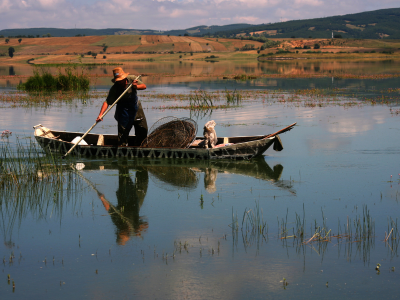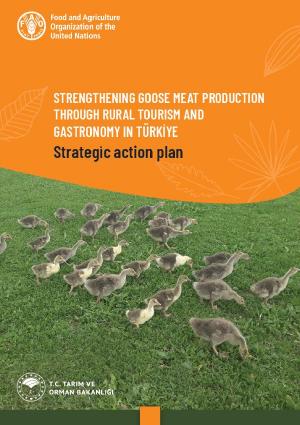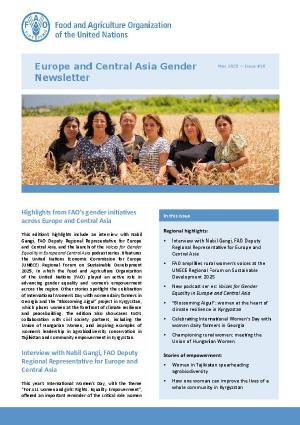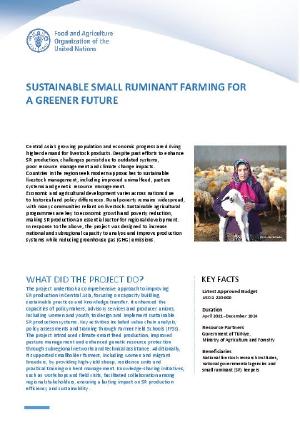
Europe and Central Asia Regional Overview of Food Security and Nutrition 2024
Managing water sustainably for improved food security and nutrition
This report provides the latest updates on hunger, food insecurity and malnutrition in Europe and Central Asia, including the cost and affordability of healthy diets. It also explores the central theme of water security, highlighting its critical connections to agriculture, food security and nutrition. While the region has made progress in reducing hunger and food insecurity (SDG Target 2.1), challenges remain in eliminating all forms of malnutrition (SDG Target 2.2).
Collections
- Country gender assessment series
- Digital agriculture
- Disaster risk reduction and management publication series
- Empowering smallholders and family farms series
- Transboundary animal diseases - Leaflets
Multimedia resources
Publications

Gender mainstreaming in climate investments in the agriculture, forestry and other land use sector in Europe and Central Asia
09/2025
This resource guide aims to support decision-makers, development practitioners, trainers and civil society organizations representing both farmers and rural women in designing and implementing climate investment projects and programmes in the Europe and Central Asia Region. It features a practical conceptual framework to enhance gender mainstreaming in climate investment programming with a particular emphasis on the Green Climate Fund and Global Environment Facility modalities.

Special issue on Land Consolidation
08/2025
A special edition of the Land Tenure Journal to commemorate 100 years of land consolidation in Europe, building on insights from an online discussion and the LANDNET workshop that took place in May 2025. This special issue aims to showcase the diverse experiences of land consolidation and outline future directions. It includes an overview paper by the FAO Regional Office for Europe and Central Asia (REU) Land Tenure Team, several papers from Western European countries detailing...

Food and agriculture Key to Achieving the 2030 Agenda for Sustainable Development in Europe and Central Asia
05/2019
This publication presents FAO's work in support of the achievement of the SDGs in Europe and Central Asia. Featuring selected country case studies across the region, it describes how FAO and partners are already supporting countries to achieve multiple SDGs targets through current project and programmes.

Reducing Vulnerability of Agriculture to Climate Change in the Former Yugoslav Republic of Macedonia - TCP/MCD/3503
05/2019
Agricultural production is inextricably tied to climate, making agriculture one of the most climate-sensitive of all economic sectors. In countries such as the former Yugoslav Republic of Macedonia, the risks of climate change for the agricultural sector are a particularly pressing problem, because the majority of the rural population depends either directly or indirectly on agriculture for their livelihoods.

Monitoring and reporting of gender equality in landownership in Albania
08/2025
Albania has committed to gender equality, aligning national laws with the 2030 Agenda for Sustainable Development and linking its European Union integration efforts with the Sustainable Development Goals (SDGs), particularly on land rights Indicators 5.a.1 and 5.a.2. Responding to the lack of data on SDG Indicators 5.a.1 and 5.a.2 in Albania, this assessment reviews policy frameworks, progress made, challenges faced and key avenues for overcoming them to enable monitoring and reporting.
.jpg?sfvrsn=7a629cbb_1)
Proceedings of the EIFAAC workshop on the problems and challenges of climate change, and its impact on inland aquatic resources and fisheries of Europe
08/2025
The EIFAAC workshop on the problems and challenges of climate change, and its impact on inland aquatic resources and fisheries of Europe was held virtually on 8 April 2025. It was organized by the EIFAAC Secretariat and Inland Fisheries Ireland. The workshop was attended by 119 participants from 23 countries.The workshop brought together leading researchers with the aim to examine how climate change is impacting inland aquatic systems and fisheries.

Transforming food and agriculture through a systems approach
07/2025
The purpose of Transforming food and agriculture through a systems approach is to clarify what a systems approach involves in practice across agrifood systems. It explains what a systems approach means in the context of agrifood systems, why it matters and how to adopt it.

FAO in Europe and Central Asia 2024
06/2025
This publication summarizes very succintly the key achievements and collaboration for the Food and Agriculture Organization of the United Nations (FAO) in the Europe and Central Asia region, despite the backdrop of ongoing challenges such as the war in Ukraine, climate change and political instability.

Impact assessment of women-led cooperative programme 2025
07/2025
The “Impact assessment of women-led cooperative programme” aims to evaluate the socioeconomic impact of FAO –Türkiye's cooperative support programme under the European Union-funded project "Promoting Resilience Through Improved Livelihoods." The results of this assessment will be instrumental in informing future programme strategies, policy recommendations and capacity-building initiatives.

Gender dynamics in pesticide use and management in Central Asia and Türkiye
07/2025
Gender and age are critical sociodemographic determinants of pesticide use, management and exposure. This paper examines pesticide use among farmers and farm workers in Azerbaijan, Kyrgyzstan, Tajikistan and Türkiye, based on farmer surveys and expert interviews conducted under the GEF/FAO project “Pesticide Life Cycle Management and Disposal in Central Asia and Türkiye” (GCP/SEC/011/GFF) in 2020 and 2021.

Strengthening goose meat production through rural tourism and gastronomy in Türkiye
07/2025
This publication summarizes the findings of an FAO-supported project on goose meat production in Kars, highlighting traditional breeding practices, value chain dynamics, and the cultural significance of geese in the region. It emphasizes the role of women and rural communities, while also exploring opportunities to link traditional food systems with rural tourism and gastronomy-based development.

Carbon markets in Europe and Central Asia
07/2025
This brief provides background information to regional and country office staff and FAO partners on the current state of carbon markets in the region. The document also shares recent developments under Article 6 of the Paris Agreement and potential regional needs for the implementation of carbon trading among countries and for the achievement of nationally determined contributions (NDCs).

Summary of the regional Virtual Learning Center activities in Europe and Central Asia as of 1 July 2025
06/2025
This fifth issue of the Virtual Learning Center (VLC) for Europe and central Asia (REU) newsletter presents a brief overview of the online courses conducted in the first half of this year and upcoming activities in the second half of 2025. Three online courses were delivered: 1) Tackling Food Loss and Waste throughout the value chain: Pilot in English in March-April 2025; 2) Zoonoses for Field Veterinarians: Pilot in English; and 3) Introduction to One Health in Ukrainian.

Digital technologies and solutions for beekeeping
04/2025
This fact sheet provides an overview of the various digital technologies used in beekeeping It addresses common challenges and seeks accessible, preferably affordable, ways to tackle them. The end goal is to introduce beekeepers to the benefits of available digital technologies and offer constructive and practical input, which can help them make better decisions, add higher value, and improve their livelihoods.

Forest pest contingency plan guidelines for Europe and Central Asia
12/2024
Pest contingency plans (PCP) are used by national or regional plant protection organizations to ensure a plan is in place for when a new pest is detected in a particular country or region, and thus to facilitate a rapid and effective response to manage the situation. This guide outlines and discusses the elements and steps needed to formulate and implement a contingency plan for key forest pests in Europe and Central Asia.

Tracking progress on food and agriculture-related Sustainable Development Goal indicators in Europe and Central Asia
06/2025
The Europe and Central Asia (ECA) region is at a key stage of the 2030 Agenda for Sustainable Development, experiencing progress in various domains – albeit with some areas witnessing limited forward movement or minor reversals. This report advocates for strengthened data systems to support evidence-based decision-making and targeted interventions.

Europe and Central Asia Gender Newsletter, May 2025 – Issue #18
06/2025
This issue of the FAO Europe and Central Asia Gender Newsletter spotlights voices and actions driving gender equality in the region’s agriculture and agrifood systems. The edition opens with an interview with Nabil Gangi, FAO Deputy Regional Representative, and introduces the Voices for Gender Equality in Europe and Central Asia podcast series.

Economic Cooperation Organization Regional Coordination Centre for Food Security (ECO-RCCFS): Advancing food security in the ECO region with FAO-Türkiye Partnership Programmes (FTPP) support
06/2025
This factsheet showcases FTPP’s support for enhancing regional cooperation on food security and sustainable food systems. It presents how FTPP has contributed to the establishment and capacity development of two key regional institutions: the Economic Cooperation Organization Regional Coordination Centre for Food Security (ECO-RCCFS) and the Black Sea Economic Cooperation Center for Sustainable Food Systems (BSEC-CSFS).

Sustainable Small Ruminant Farming for a Greener Future
04/2025
Central Asia's growing population and economic progress are driving higher demand for livestock products. Despite past efforts to enhance SR production, challenges persist due to outdated systems, poor resource management and climate change impacts. Countries in the region seek modern approaches to sustainable livestock management, including improved animal feed, pasture systems and genetic resource management.

University curriculum assessment on the learning outcomes related to antimicrobial resistance at the Faculty of Veterinary Sciences at the Tajik Agrarian University named after Shirinsho Shotemur
04/2025
The Strengthening Veterinary Education on Antimicrobial Resistance series compiles assessment reports of veterinary education institutions, detailing strengths and areas for improvement in the institutions’ curricula, and recommendations to enhance their education on antimicrobial resistance (AMR) learning outcomes. This issue of the series summarizes the findings of the assessment conducted at the Faculty of Veterinary Sciences at the Tajik Agrarian University in Dushanbe, Tajikistan.
